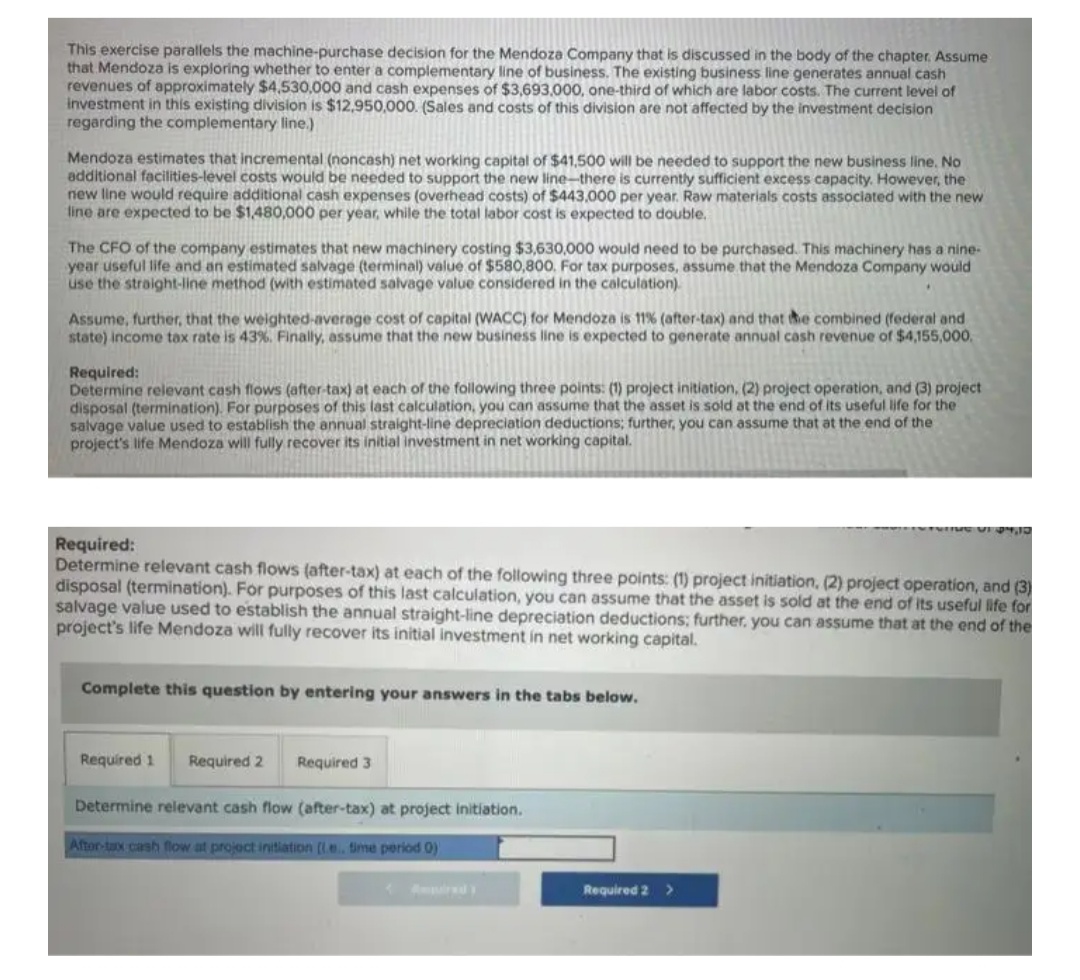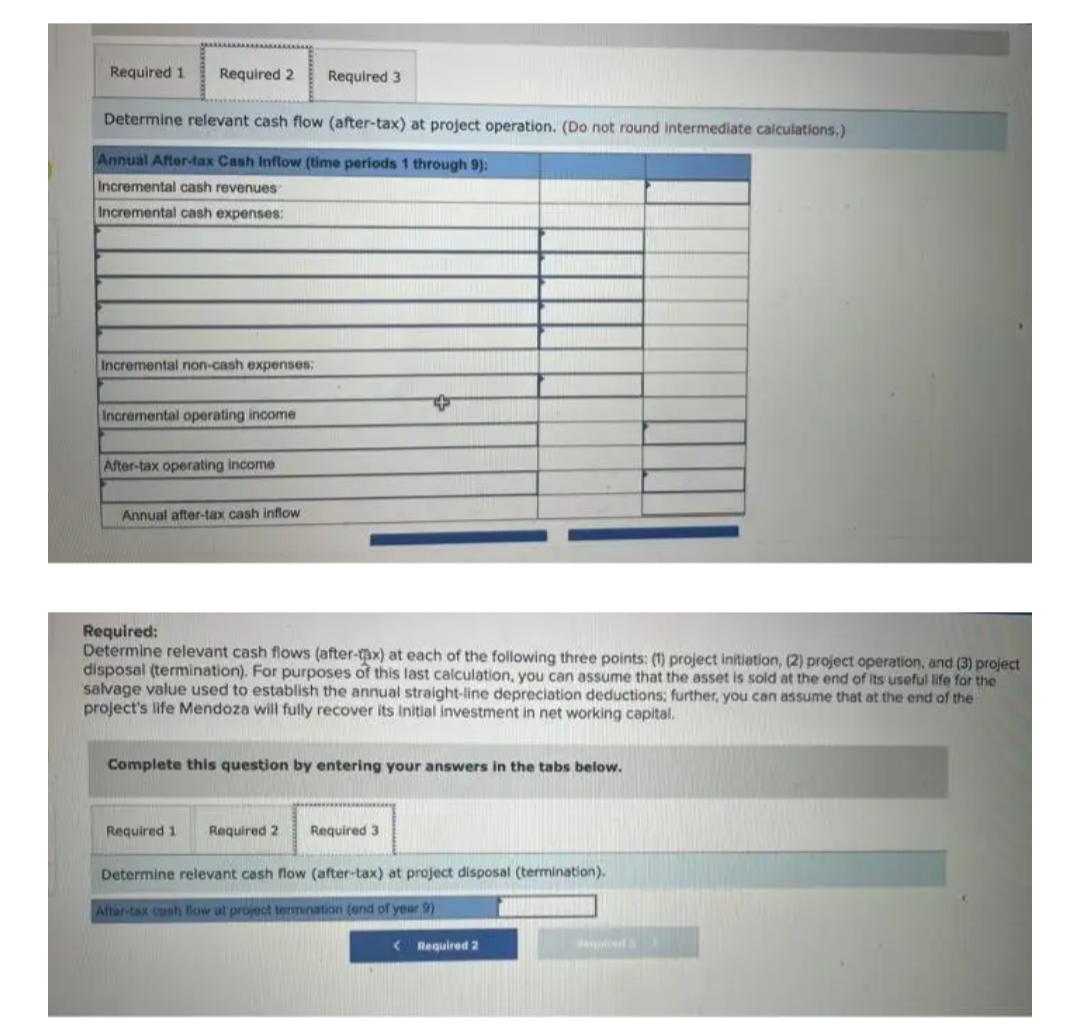This exercise parallels the machine-purchase decision for the Mendoza Company that is discussed in the body of the chapter. Assume that Mendoza is exploring whether to enter a complementary line of business. The existing business line generates annual cash revenues of approximately $4,530,000 and cash expenses of $3,693,000, one-third of which are labor costs. The current level of investment in this existing division is $12,950,000. (Sales and costs of this division are not affected by the investment decision regarding the complementary line.) Mendoza estimates that incremental (noncash) net working capital of $41,500 will be needed to support the new business line. No additional facilities-level costs would be needed to support the new line-there is currently sufficient excess capacity. However, the new line would require additional cash expenses (overhead costs) of $443,000 per year. Raw materials costs associated with the new line are expected to be $1,480,000 per year, while the total labor cost is expected to double. The CFO of the company estimates that new machinery costing $3,630,000 would need to be purchased. This machinery has a nine- year useful life and an estimated salvage (terminal) value of $580,800. For tax purposes, assume that the Mendoza Company would
This exercise parallels the machine-purchase decision for the Mendoza Company that is discussed in the body of the chapter. Assume that Mendoza is exploring whether to enter a complementary line of business. The existing business line generates annual cash revenues of approximately $4,530,000 and cash expenses of $3,693,000, one-third of which are labor costs. The current level of investment in this existing division is $12,950,000. (Sales and costs of this division are not affected by the investment decision regarding the complementary line.) Mendoza estimates that incremental (noncash) net working capital of $41,500 will be needed to support the new business line. No additional facilities-level costs would be needed to support the new line-there is currently sufficient excess capacity. However, the new line would require additional cash expenses (overhead costs) of $443,000 per year. Raw materials costs associated with the new line are expected to be $1,480,000 per year, while the total labor cost is expected to double. The CFO of the company estimates that new machinery costing $3,630,000 would need to be purchased. This machinery has a nine- year useful life and an estimated salvage (terminal) value of $580,800. For tax purposes, assume that the Mendoza Company would
Principles of Cost Accounting
17th Edition
ISBN:9781305087408
Author:Edward J. Vanderbeck, Maria R. Mitchell
Publisher:Edward J. Vanderbeck, Maria R. Mitchell
Chapter6: Process Cost Accounting—additional Procedures; Accounting For Joint Products And By-products
Section: Chapter Questions
Problem 13P: Venezuela Oil Inc. transports crude oil to its refinery where it is processed into main products...
Related questions
Question
4

Transcribed Image Text:This exercise parallels the machine-purchase decision for the Mendoza Company that is discussed in the body of the chapter, Assume
that Mendoza is exploring whether to enter a complementary line of business. The existing business line generates annual cash
revenues of approximately $4,530,000 and cash expenses of $3,693,000, one-third of which are labor costs. The current level of
investment in this existing division is $12,950,000. (Sales and costs of this division are not affected by the investment decision
regarding the complementary line.)
Mendoza estimates that incremental (noncash) net working capital of $41,500 will be needed to support the new business line. No
additional facilities-level costs would be needed to support the new line-there is currently sufficient excess capacity. However, the
new line would require additional cash expenses (overhead costs) of $443,000 per year. Raw materials costs associated with the new
line are expected to be $1,480,000 per year, while the total labor cost is expected to double.
The CFO of the company estimates that new machinery costing $3,630,000 would need to be purchased. This machinery has a nine-
year useful life and an estimated salvage (terminal) value of $580,800. For tax purposes, assume that the Mendoza Company would
use the straight-line method (with estimated salvage value considered in the calculation).
Assume, further, that the weighted-average cost of capital (WACC) for Mendoza is 11% (after-tax) and that the combined (federal and
state) income tax rate is 43%. Finally, assume that the new business line is expected to generate annual cash revenue of $4,155,000.
Required:
Determine relevant cash flows (after-tax) at each of the following three points: (1) project initiation, (2) project operation, and (3) project
disposal (termination). For purposes of this last calculation, you can assume that the asset is sold at the end of its useful life for the
salvage value used to establish the annual straight-line depreciation deductions; further, you can assume that at the end of the
project's life Mendoza will fully recover its initial investment in net working capital.
$4,10
Required:
Determine relevant cash flows (after-tax) at each of the following three points: (1) project initiation, (2) project operation, and (3)
disposal (termination). For purposes of this last calculation, you can assume that the asset is sold at the end of its useful life for
salvage value used to establish the annual straight-line depreciation deductions; further, you can assume that at the end of the
project's life Mendoza will fully recover its initial investment in net working capital.
Complete this question by entering your answers in the tabs below.
Required 1 Required 2 Required 3
Determine relevant cash flow (after-tax) at project initiation.
Aftor-tax cash flow at project initiation ((.e. time period 0)
Required 2 >

Transcribed Image Text:Required 1 Required 2 Required 3
Determine relevant cash flow (after-tax) at project operation. (Do not round intermediate calculations.)
Annual After-tax Cash Inflow (time periods 1 through 9):
Incremental cash revenues
Incremental cash expenses:
Incremental non-cash expenses;
Incremental operating income
After-tax operating income
Annual after-tax cash inflow
Required:
Determine relevant cash flows (after-tax) at each of the following three points: (1) project initiation, (2) project operation, and (3) project
disposal (termination). For purposes of this last calculation, you can assume that the asset is sold at the end of its useful life for the
salvage value used to establish the annual straight-line depreciation deductions: further, you can assume that at the end of the
project's life Mendoza will fully recover its Initial investment in net working capital.
Complete this question by entering your answers in the tabs below.
Required 1
Required 2 Required 3
Determine relevant cash flow (after-tax) at project disposal (termination).
After-tax cash flow at project termination (end of year 9)
< Required 2
Expert Solution
This question has been solved!
Explore an expertly crafted, step-by-step solution for a thorough understanding of key concepts.
This is a popular solution!
Trending now
This is a popular solution!
Step by step
Solved in 2 steps with 2 images

Recommended textbooks for you

Principles of Cost Accounting
Accounting
ISBN:
9781305087408
Author:
Edward J. Vanderbeck, Maria R. Mitchell
Publisher:
Cengage Learning

Managerial Accounting
Accounting
ISBN:
9781337912020
Author:
Carl Warren, Ph.d. Cma William B. Tayler
Publisher:
South-Western College Pub

Survey of Accounting (Accounting I)
Accounting
ISBN:
9781305961883
Author:
Carl Warren
Publisher:
Cengage Learning

Principles of Cost Accounting
Accounting
ISBN:
9781305087408
Author:
Edward J. Vanderbeck, Maria R. Mitchell
Publisher:
Cengage Learning

Managerial Accounting
Accounting
ISBN:
9781337912020
Author:
Carl Warren, Ph.d. Cma William B. Tayler
Publisher:
South-Western College Pub

Survey of Accounting (Accounting I)
Accounting
ISBN:
9781305961883
Author:
Carl Warren
Publisher:
Cengage Learning

Financial And Managerial Accounting
Accounting
ISBN:
9781337902663
Author:
WARREN, Carl S.
Publisher:
Cengage Learning,

Cornerstones of Cost Management (Cornerstones Ser…
Accounting
ISBN:
9781305970663
Author:
Don R. Hansen, Maryanne M. Mowen
Publisher:
Cengage Learning